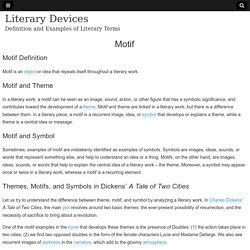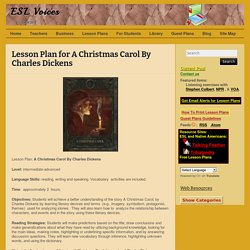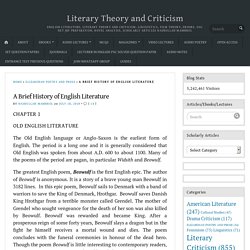

Thomas Lewandowski. Youtube. Thank you m am do now s. TeachHUB LP “The Lottery” Shirley Jackson. Motif - Examples and Definition of Motif. Motif Definition Motif is an object or idea that repeats itself throughout a literary work.

Motif and Theme. The lottery discussion questions1. Youtube. Tone, Mood and Setting - Elements of Narratives. Mood and Tone - Mrs. Nethery's Class. What is Mood?

Key Term: Mood-Mood is a literary element that evokes certain feelings or vibes in readers through words and descriptions. As a literary device, mood is the emotional feeling or atmosphere that a work of literature produces in a reader. What Makes Up a Mood? These are the basic elements that help determine the mood of a piece of writing:Setting: A story's setting is where and when it takes place. Setting is one of the first things to be described in a narrative, and therefore plays a major role in establishing the mood.In the "dark and stormy night" example from above, the story's mood is established almost entirely by the setting (in this case, the weather and the time of day), which makes for a gloomy and potentially even frightening atmosphere.
Examples of Mood in CinemaOne good way to see mood (and, to a degree, tone) in action is through genre-crossing movie trailers. The lottery discussion analysis questions. For ESL English Language Learners. A CHRISTMAS CAROL BY CHARLES DICKENS - ANIMATED BOOK SUMMARY. Lesson Plan for A Christmas Carol By Charles Dickens. Lesson Plan: A Christmas Carol By Charles Dickens Level: intermediate-advanced Language Skills: reading, writing and speaking.

Vocabulary activities are included. Time: approximately 2 hours. Objectives: Students will achieve a better understanding of the story A Christmas Carol, by Charles Dickens by learning literary devices and terms (e.g., imagery, symbolism, protagonist, themes) used for analyzing stories. Reading Strategies: Students will make predictions based on the title; draw conclusions and make generalizations about what they have read by utilizing background knowledge, looking for the main ideas, making notes, highlighting or underlining specific information, and by answering discussion questions.
Materials: An ebook copy of the story A Christmas Carol, biography of Charles Dickens, Examples of Components for Literary Analysis I. Background information: Some points about the life of Charles Dickens to help students make connections to the story. Stimulating Background Knowledge.
A Midsummer Night's Dream(2014)Part 1/3 Shakespeare's Globe On Screen(one of the best)─影片 Dailymotion. Playing Shakespeare with Deutsche Bank. Literary Periods & Genres - English Literature - LibGuides at Mississippi College-Leland Speed Library. I.

HOMERIC or HEROIC PERIOD (1200-800 BCE) Greek legends were passed along orally, including Homer's The Iliad and The Odyssey. This is a chaotic period of warrior-princes, wandering sea-traders, and fierce pirates. Greek writers, playwrights, and philosophers include Gorgias, Aesop, Plato, Socrates, Aristotle, Euripides, and Sophocles. The fifth century (499-400 BCE) in particular is renowned as The Golden Age of Greece.
Greece's culture gave way to Roman power when Rome conquered Greece in 146 CE. IV. Early Christian writers include Saint Augustine, Tertullian, Saint Cyprian, Saint Ambrose and Saint Jerome. Introduction to Literature. Old Fence.

A short story has a structure and a message. Can you analyze this picture in much the same way as a short story? HISTORY OF ENGLISH LITERATURE. The tone of oblique irony which Swift makes his own is evident even in the title of his 1708 attack on fashionable trends in religious circles - An Argument to prove that the Abolishing of Christianity in England, may as Things now stand, be attended with some Inconveniences.

In the following year, 1709, a new periodical brings a gentler brand of humour and irony hot off the presses, three times a week, straight into London's fashionable coffee houses. The Tatler, founded by Richard Steele with frequent contributions from his friend Joseph Addison, turns the relaxed and informal essay into a new journalistic art form. In 1711 Steele and Addison replace the Tatler with the daily Spectator. A Brief History of English Literature. The Old English language or Anglo-Saxon is the earliest form of English.

The period is a long one and it is generally considered that Old English was spoken from about A.D. 600 to about 1100. Many of the poems of the period are pagan, in particular Widsith and Beowulf. The greatest English poem, Beowulf is the first English epic. The author of Beowulf is anonymous. It is a story of a brave young man Beowulf in 3182 lines. The difficulty encountered in reading Old English Literature lies in the fact that the language is very different from that of today. Besides Beowulf, there are many other Old English poems.
Two important figures in Old English poetry are Cynewulf and Caedmon. Alfred enriched Old English prose with his translations especially Bede’s Ecclesiastical History. Middle English Literature Geoffrey Chaucer Poet Geoffrey Chaucer was born circa 1340 in London, England. William Shakespeare - Mini Biography. 'Shall I compare thee to a summer's day?' - Shakespeare's Sonnet 18. Modern Era: Katherine Mansfield - A Cup of Tea (Lecture)